The ASUS X99-E-10G WS Motherboard Review: 10GBase-T Networking with Intel’s X550-AT2
by Ian Cutress on November 7, 2016 9:00 AM EST- Posted in
- Motherboards
- Intel
- Asus
- 10G Ethernet
- X99
- 10GBase-T
- X99-E-10G WS
- X550
- X550-AT2
SLI, SLI, SLI
In our last review of a motherboard capable of 4-way GPU gaming, it was eloquently stated that our failure to test the feature was an indication of AnandTech’s current path on quality. I would have preferred a discourse in actually being able to source four identical GPUs at the time (and then showing ‘wow, it works’ in the review). There are plenty of things we don’t test as rigorously on each product that some users might like, such as PCIe x1 slot bandwidth latency, or USB 2.0 performance on CentOS, either due to time, relevance, or as was the case before, a lack of hardware. This is still the case - I do not have four expensive and high profile GPUs and I live a whole continent and an ocean away from our GPU testing facility. I have procured a third identical GTX 980 however, and will show you that at least 3-way GPU works in our test suite.
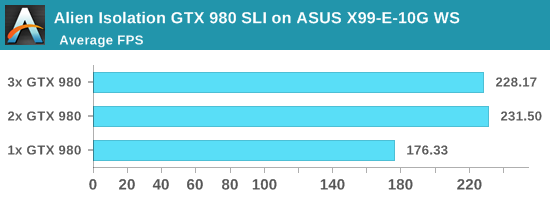
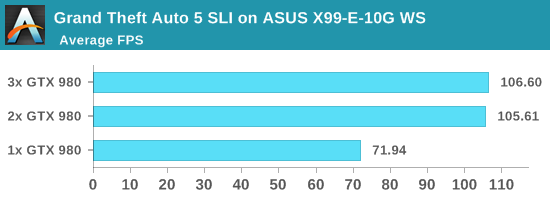
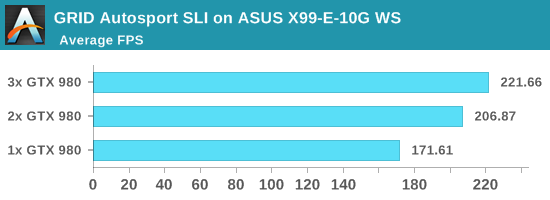
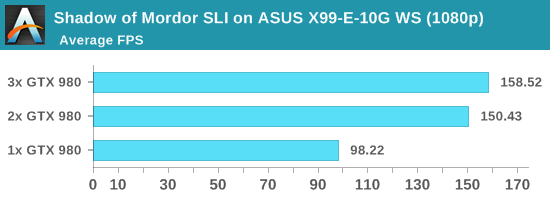
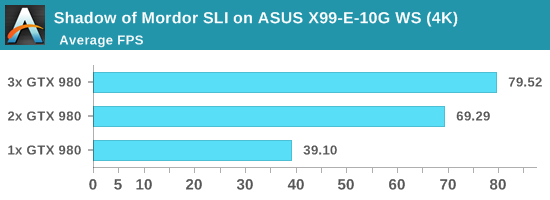
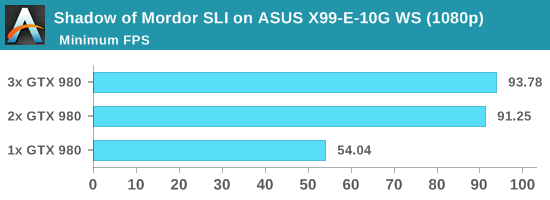
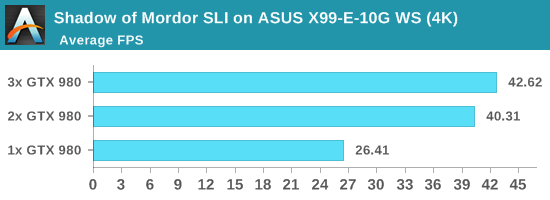
GPU scaling beyond two cards depends on the game engine and the drivers, or if the game has implemented specific multi-GPU modes to accelerate game features. For some titles, the GPU is not the bottleneck, and it might either be CPU performance, PCIe bandwidth, DRAM, or the fact that the game doesn’t scale and we’re relying on the performance of a single card.
Both GTA5 and Alien Isolation scaled to two cards with our hardware setup, but failed to move going to three. GRID is typically a title that scales with almost anything, however the jump from two to three cards was only 7%.
Shadow of Mordor gets the best scaling, but only at 4K and not at 1080p. At 1080p the move from 1 GPU (98 FPS) to 2 GPUs (150 FPS) is significant, but 3 GPUs (158 FPS) is not. For 4K, the scaling keeps going from 1 GPU (39 FPS) to 2 GPUs (69 FPS) and 3 GPUs (80 FPS), although not as much for that last jump. At 4K we are running at our Ultra preset, indicating that some other hard compute part of frame rendering might be the limiting factor in AFR modes.
Testing 10GBase-T and X550-AT2
Similar to our GPU testing, we have not the ideal hardware for Ethernet testing. In our previous 10G motherboard review, we implemented an ESXi 6 platform and used two Windows Server VMs, each with 8 threads, 16GB of DRAM, and one of the 10G ports. As a result each VM had a direct OS-to-OS 10G connection with a custom configured IP and testing was done.
Testing 10G with ESXi was actually more difficult this time around. The X550 series of drivers are not supporting in the default image, requiring the admin to install the relevant plug-in. While this enabled the ports to work in the Windows Server 2016 VMs, ESXi would not allow them under VSXNET mode, which is typically the high-performance mode. I was unable to find a quick solution, and along with the X550 controller being newer, deciphering what needed to be done was also a minefield of frustration.
It is interesting then to note that our results for the ASUS board and X550 are similar to previous results with the ASRock board using X540. This is ultimately because the chips are mostly similar, with the primary difference in the way they communicate with the CPU – the X540 requires PCIe 2.0 x8, while the X550 requires PCIe 3.0 x4. The X550 also introduces some professional level features, but the 10G copper market remains in Intel’s hands without another major player (or that professional environments turn to fiber).
When we last performed this with the ASRock X99 WS-E/10G, and a number of our readers were very helpful in describing ways in which 10G network performance (with the right hardware and knowledge) could be improved. As our test is point-to-point without a managed switch, and the frustrating element of learning to debug the environment, I highly recommend you read the post by Jammrock back in that review. But the 10G ports do both work, I can tell you that.











63 Comments
View All Comments
Notmyusualid - Friday, December 2, 2016 - link
TB3 IS great! - but not for the use case you describe, I think.r3loaded - Monday, November 7, 2016 - link
So why exactly IS 10G so expensive? Is there some inherent technical reason, or is it just Intel doing what Intel does best with a captive market over which they have a near monopoly?jhh - Monday, November 7, 2016 - link
Volume. There is a certain amount of engineering involved in making the NIC, and if you expect to sell 100,000, you recoup that engineering expense differently than if you expect to sell 10,000,000. I'm sure the volume is somewhere between those two targets. Volume will be limited if for no other reason that most devices connect via WiFi, and that until WiFi routers come with something other than a 1G port, it's hard to drive the market for 10G. The server environment is different, but fewer servers are sold than laptop/tablet/phone. No one is selling > 1G Internet to the residential market, so even that option isn't driving the market. One is then limited to people with the need to transfer at more than 1G speeds within a residence, and that market is small. Servers tend to use fiber, as the signal processing to support 10G over copper was historically adding significant latency compared to fiber. Fiber is also more forward compatible to 25G than copper, as every speed transition has always required different cables. Unless you are installing Cat 7a wire and proprietary connectors, but they aren't directly compatible with 1G wiring.Communism - Monday, November 7, 2016 - link
http://ark.intel.com/products/84329/Intel-Ethernet...The price per thousand is down to 80 USD for the controller (Which provides 2x 10G base-t ports), meaning one could theoretically integrate it into an x99 (or the boards coming out for Skylake-E/X) for around that much if you could get enough traction to be able to put them in a board with a significant portion of sales.
This sounds entirely feasible, unfortunately, they seem to be stuck on boards that are made purely for manufacturer advertising with hilarious prices like 700 USD.
Integrating such a controller is simple, as it's just a PCIe 3.0 x4 device.
Hopefully at least 1 of the major board manufacturers starts making reasonable integrations with the X550-AT2 controller in the Skylake-E/X generation boards.
bronan - Friday, November 11, 2016 - link
Intel sold their 10G cards for under 100 dollar each, when companies jumped onto them they slowly upped the prices to the max. These cards can be sold for under 50 dollar each but the hunger for huge profits will not allow thatBillR - Tuesday, November 8, 2016 - link
Terrific answer. 1G is everywhere and cost for those ports shows the power of huge volumes on prices. However, 10G is mostly limited to servers and there is a lot of competition for server connections (25G, 40G, 50G, 100G, Infiniband, etc.). Unfortunately fragmentation means higher prices.Ranger1065 - Monday, November 7, 2016 - link
zzzZZzzz.....bronan - Friday, November 11, 2016 - link
These chips cost really nothing for the gaints, the real prices of these chips are absolute below 10 dollar each. Again intel sold full fledged pci cards if i remember well around 77 dollar thats consumer price. See what happened after the companies started adopted them. I can't believe everbody makes it look like it so expenssive to make chips.... They cost them a few bucks to make thats it not 50 dollar+ my company makes chips for certain installations they costs 0.04 cents each and are sold to companies for 11 cents each ... talking about making profit. Thats the real prices you as consumer pay for that same 11 cents .... 10 dollar+ yes thats how the market works these days enormous profit is all what countsnirsever - Tuesday, November 8, 2016 - link
In fact, the footprint of the Tehuti Networks based solutions with PHYs from either Marvell or Aquantia are way smaller than the Intel X550 and since they don't require a heat sink, consuming ~5W max (for both MAC and PHY), they are much easier to integrate. The Tehuti Networks solutions are already supporting 2.5G and 5G in addition to standard 10GBase-T. You can find Tehuti Networks based 5-speed NIC cards already selling today for ~$200 while this figure is expected to drop significantly once new Marvell 802.3bz PHYs will start shipping in volumes early next yearnirsever - Tuesday, November 8, 2016 - link
Please take a look at what you can expect from Tehuti Networks and Marvell new PHY:http://www.tehutinetworks.net/?t=LV&L1=3&L...